Sundial Atlas Paper Sundials
- Details
- Hits: 19161
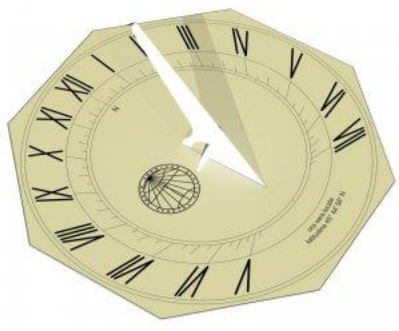 Need a small sundial for your display or science project? Want to show how different sundials cast shadows? Need a simple cut-out science exercise for your students? Fabio Savian of Milan Italy has the solution. For a number of years he has managed the Sundial Atlas website, ever increasing the number of sundial photos from around the world. Over the last several years he has worked very hard to create the gnomolab that includes a solar compass map of the earth, cloud software for creating analemmatic (human shadow) sundials, and a section for making paper sundials to your specification. The analemmatic dial measurements and papger dial designs are created as download PDF files. Four of those dials were created by the North American Sundial Society. Enjoy. Sundial Atlas Paper Sundials
Need a small sundial for your display or science project? Want to show how different sundials cast shadows? Need a simple cut-out science exercise for your students? Fabio Savian of Milan Italy has the solution. For a number of years he has managed the Sundial Atlas website, ever increasing the number of sundial photos from around the world. Over the last several years he has worked very hard to create the gnomolab that includes a solar compass map of the earth, cloud software for creating analemmatic (human shadow) sundials, and a section for making paper sundials to your specification. The analemmatic dial measurements and papger dial designs are created as download PDF files. Four of those dials were created by the North American Sundial Society. Enjoy. Sundial Atlas Paper Sundials
Connetquot Students Use Sundials to Tell Time
- Details
- Hits: 12498
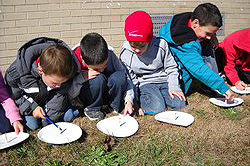 Second-grade students at Connetquot Elementary School in Islip, New York, created sundials using paper plates and pencils. The pencil gnomons were set mostly vertical by the students and then they traced the resulting shadows at three times during the day. This helped teachers Leslie Davis and Melissa Love demonstrate the sun’s apparent movement in the sky and talk about the earth's rotation as the cause. "The students really had fun," said Love, "and they were able to recognize that a sundial is a tool that can be used to measure time."
Second-grade students at Connetquot Elementary School in Islip, New York, created sundials using paper plates and pencils. The pencil gnomons were set mostly vertical by the students and then they traced the resulting shadows at three times during the day. This helped teachers Leslie Davis and Melissa Love demonstrate the sun’s apparent movement in the sky and talk about the earth's rotation as the cause. "The students really had fun," said Love, "and they were able to recognize that a sundial is a tool that can be used to measure time."
Sundials in Grammar School
- Details
- Hits: 10528
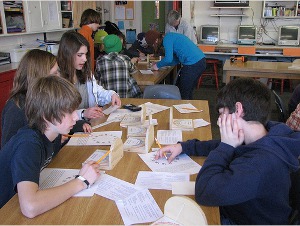 Avid dialist and former The Grammar School teacher and head of the Putney, VT school, Mac Oglesby guides 6th graders to plan and construct their own working sundials. Oglesby's students learned how to correctly position their dials to display the accurate time throughout the year.
Avid dialist and former The Grammar School teacher and head of the Putney, VT school, Mac Oglesby guides 6th graders to plan and construct their own working sundials. Oglesby's students learned how to correctly position their dials to display the accurate time throughout the year.
Brief History of Sundials and How to Make & Use Them
- Details
- Hits: 8409
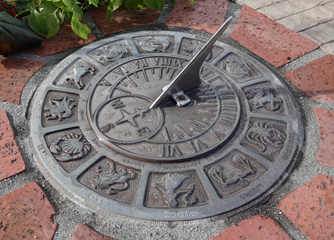 Dr. Jessica Warren, lecturer of physics and astronomy at Indiana University Northwest, is active in science outreach and education. She is also passionate about sundials. For Indiana University outreach shecreated a video "The Garden Sundial - Much More than an Ornament" that presents a brief history of the sundial, how they work, and where to get one or make one.
Dr. Jessica Warren, lecturer of physics and astronomy at Indiana University Northwest, is active in science outreach and education. She is also passionate about sundials. For Indiana University outreach shecreated a video "The Garden Sundial - Much More than an Ornament" that presents a brief history of the sundial, how they work, and where to get one or make one.
You can watch the video on YouTube at https://www.youtube.com/watch?v=K10nPV69Q1A. It is also part of the North American Sundial Society library of videos, found on this website at https://sundials.org/videos/making-and-using-sundials.html where NASS has a collection of videos on sundials, timekeeping, and interviews with sundialists on how they make sundials.
At the end of her presentation, Dr. Warren provides a list of reference material about sundials. Her entire video including references is available as a PDF and is available for download at the bottom of this article. Additional references and sundial topics are available on the NASS sundial links page: https://sundials.org/dial-links/general-sundial-links.html. Read more about the fascinating world of sundials.
Solargraphy - Takes a while - But it's worth it
- Details
- Hits: 14424
 In the NASA Photograph of the Day for 27 June 2019 is a beautiful photograph by Gianluca Belgrado using a pinhole camera. https://apod.nasa.gov/apod/ap190627.html As explained by NASA, "This persistent six month long exposure compresses the time from solstice to solstice (December 21, 2018 to June 16, 2019) into a single point of view....Fixed to a single spot at Casarano, Italy for the entire exposure, the simple [pinhole] camera continuously records the Sun's daily path as a glowing trail burned into the photosensitive paper. Breaks and gaps in the trails are caused by cloud cover. At the end of the exposure, the paper was scanned to create the digital image...."
In the NASA Photograph of the Day for 27 June 2019 is a beautiful photograph by Gianluca Belgrado using a pinhole camera. https://apod.nasa.gov/apod/ap190627.html As explained by NASA, "This persistent six month long exposure compresses the time from solstice to solstice (December 21, 2018 to June 16, 2019) into a single point of view....Fixed to a single spot at Casarano, Italy for the entire exposure, the simple [pinhole] camera continuously records the Sun's daily path as a glowing trail burned into the photosensitive paper. Breaks and gaps in the trails are caused by cloud cover. At the end of the exposure, the paper was scanned to create the digital image...."
In 2011 Art Paque explained the art of solargraphy to members of the North American Sundial Society at their annual conference in Seattle. The construction steps involve creating a pinhole in thin foil, then taping the foil onto a tin can that has photographic paper inside and opposite the pinhole. The lid on the can is sealed and most important, pointed at the sky with firm support to prevent moving. The rest is up to nature as the sun crosses the sky each day. Beautiful solargaphs such as from Gianluca can be obtained with patience tracking the sun for three to six months. In the end your solargarph will be a day by day time capsule of solar observation.
Type "solagraphy" into your web search engine and you will discover a host of sites showing the details of making your pinhole camera. For example: http://www2.uiah.fi/%7ettrygg/camera.html and http://www.pinholephotography.org/Solargraph%20instructions%202.htm

Waterloo 3D Sundial Arches
- Details
- Hits: 10367
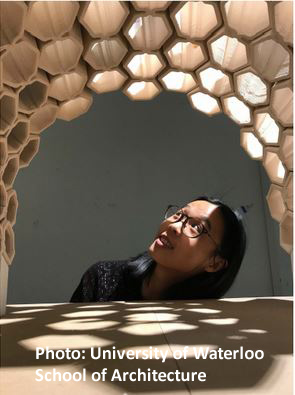 Students at the University of Waterloo School of Architecture in Cambridge, Ontario are experimenting with the benefits of 3D design and printing. In particular Joanne Yau created a set of hexagonal hollow bricks called sundial arches that lets in sunlight from different portions of the arch as the sun travels across the sky. We expect that the length to width ratio of the bricks can tailor sunlight for specific times of the year (summer, spring/fall, or winter).
Students at the University of Waterloo School of Architecture in Cambridge, Ontario are experimenting with the benefits of 3D design and printing. In particular Joanne Yau created a set of hexagonal hollow bricks called sundial arches that lets in sunlight from different portions of the arch as the sun travels across the sky. We expect that the length to width ratio of the bricks can tailor sunlight for specific times of the year (summer, spring/fall, or winter).
Joanne Yau was one of three teams challenged to learn how to operate a new industrial 3D printer capable of squirting out clay. Professor Correa, interviewed by 3Dprint.com said “There is no other way to make these kinds of façades without enormous cost and time,” said Correa, who has been involved in 3D printed research on an even more advanced level, studying how such objects respond when exposed to varying degrees of moisture and temperature. “They are completely unique.” “The printer allows us to make much more complex geometry,” said Joanne Yau, part of the team that 3D printed bricks for the ambitious arch/sundial. “To make this by hand or to extrude it would be virtually impossible.”
See a video of how the 3D clay bricks are created in an article by Bridget O'Neal June 5, 2019: https://3dprint.com/245698/whistling-walls-sundial-arches-ontario-architecture-students-3d-print-clay/
Teachers & Architects Draw Sundials
- Details
- Hits: 9628
 Grimm & Parker Architects sponsored a "Green Apple Day" on October 15, 2016 to help two Baltimore City Schools - Graceland Park ES/MS and Holabird Academy ES/MS - receive analemmatic sundials on their front sidewalks. The weather was perfect as teachers and volunteers from G&P chalked out and then painted simple 16 x 5 foot analemmatic sundials.
Grimm & Parker Architects sponsored a "Green Apple Day" on October 15, 2016 to help two Baltimore City Schools - Graceland Park ES/MS and Holabird Academy ES/MS - receive analemmatic sundials on their front sidewalks. The weather was perfect as teachers and volunteers from G&P chalked out and then painted simple 16 x 5 foot analemmatic sundials.
The sidwalks were aligned true North-South, making dial lay-out easy. With tape measures in hand, they marked out the focal points and north point of the analemmatic ellipse. Then, using the time-honored principle of constant distance they used a chalk line between those 3 points to maneuver a piece of chalk following the shape of an ellipse. For the sundial, the ellipse stretched from 5am to 7pm. The hour marks were made using two tape measure to check positions that were quickly followed by drawing of the hour circles with a plastic lid. While volunteers painted the hour circles others chalked out the walkway whose monthly lines and solstices were quickly painted as well. The final touch was the inclusion of the East and West Bailey points that determine the direction of the rising and setting sun. With a lot of support and good organization, both dials were finished in 3 hours!
Museo Galileo
- Details
- Hits: 5751
Want to travel? Want to see sundials? Well, you can do both by taking a virtual tour of the Galileo Museum (Museo Galileo) in Florence, Italy. Beside showing you detailed sundials, astrolabes, and quadrants in their collection, they host a series of short 2 minute videos on sundials and many other topics.
This is a fun virtual site to explore: https://catalogue.museogalileo.it/ Here you can read about the biography of Galileo or many other famous scientists or you may want to browse many of 1000 astronomical instruments in their collection, or watch a video on Galileo's astronomy or see how the the heavens can be seen in the armillary sphere sundial, or consider the history of the lightning rod with a demostration of gunpowder blowing apart a small wooden house (called a "Thunder House") that doesn't have one.
There are many short videos about sundials and astrolabes. And of course there is the Monumental Sundial at the entrance to Museo Galileo. Click here to watch a short animation of how this gnomonic sundial works. The Museum has many of these instructional videos. Be sure to visit their video catalogue: https://catalogue.museogalileo.it/index/VideoIndexByThematicArea.html
Sunlight and the 1918 Spanish Flu
- Details
- Hits: 11912
.jpeg) 1918 Photo of Camp Brooks Open-Air Hospital Boston - Nat'l Archives 1918 Photo of Camp Brooks Open-Air Hospital Boston - Nat'l Archives |
We feel the menance of the Corona Virus (Covid-19) and the imposed social isolation. Although worse than the typical annual flu, the Corona Virus pales to the worldwide pandemic of the Spanish Flu (isolated as the H1N1 virus). What does this have to do with sunlight? I am indebted to Richard Hobday's well researched article:
Here is his paragraph on "Sunlight and Influenza Infection"
"Putting infected patients out in the sun may have helped because it inactivates the influenza virus.[7] It also kills bacteria that cause lung and other infections in hospitals.[8] During the First World War, military surgeons routinely used sunlight to heal infected wounds.[9] They knew it was a disinfectant. What they didn’t know is that one advantage of placing patients outside in the sun is they can synthesise vitamin D in their skin if sunlight is strong enough. This was not discovered until the 1920s. Low vitamin D levels are now linked to respiratory infections and may increase susceptibility to influenza.[10] Also, our body’s biological rhythms appear to influence how we resist infections.[11] New research suggests they can alter our inflammatory response to the flu virus.[12] As with vitamin D, at the time of the 1918 pandemic, the important part played by sunlight in synchronizing these rhythms was not known."

